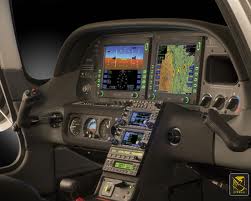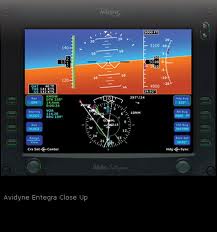High Performance Aviation
A Glass Cockpit Buyer’s Guide
By Hank Gibson, Gold Seal, CFI, CFII, MEI
I’m a Garmin guy, through and through. Most of my glass panel experience is with Garmins, but I’ve been flying an Avidyne setup a lot lately, so I consider myself unbiased. I’ll let you be the final judge in the end, but I’ll try and present a bipartisan view of both systems as best I can. Now, just sit back and get ready to form an opinion. (Note: The Avidyne Entegra discussion below is specific to a Cirrus SR22)
The Avidyne Entegra

Avidyne has done many things well with their venture into the glass cockpit arena (brief side note: I find it humorous that even Avidyne still uses Garmin’s GPS. As usual, I digress). On the PFD, there are eight bezel keys, four on each side, each with it’s own function. On the bottom of the display are two knobs, one on each side, that are used to input information into each of the different fields next to the bezel keys.
The instrumentation display on the PFD is unique. The attitude, airspeed, and vertical speed indicators are all displayed in the top half of the display. The typical coloring for the attitude indicator (sky is blue, ground is brown) remains only in the top portion of the display. The HSI along with the bezel keys are all in the lower half of the display, with black being the background color here. Your course lines are displayed in the lower half as well. Whatever you input into your flight plan in the GPS will be underlayed on the HSI and the surrounding black screen.
Moving to the MFD, the knob on the lower left gives you the ability to scroll through a myriad of different pages, depending on what your plane is equipped with. The default page that comes up upon startup is the engine page. Typically, as do almost all pilots, I keep the map page up on the MFD. The Cirrus I fly has a TAWS terrain system on the second page. There is also a trip page, a chart page (assuming you have the subscription), an electronic checklist page, which allows more streamlined checklist usage (and takes away flipping through a booklet), and the nearest page.
Now, looking through that list, some of what will be in your airplane largely depends upon what you want to put in there. I would highly recommend the electronic checklist and the CMAX Jeppesen chart subscription. The TAWS is nice to have, but not a necessity. Situation awareness is always a priority, and the more you have the better.
You’re probably thinking at this point, what about traffic alerts? Well, for those, you have to go through the Garmin GPS. Sorry, I’m talking about Garmin again. Let’s get back to Avidyne.
The ten bezel keys control many different functions depending on which page you are on. To learn each of the bezel keys, you’ll really have to just go through the different pages, exploring and discovering all the complexities of the system. There are a few online simulators that you can play with, too (Avidyne Trainer).

The Comparison
Here’s the problem with Avidyne that I have found. It is a little simpler and a little more user friendly, but the integration is lacking. The nice thing about a G1000 setup is the way everything is integrated within the actual system. There isn’t a GPS built into the glass panel in this system. You still have to get either a Garmin GPS and a second Com radio, or two Garmins. With a G1000, the GPS is already in the system, as well as the audio panel. You’ve got your frequencies on the screen already, instead of having to look elsewhere for them.
I’ve heard the knock on the G1000 is that the soft keys perform many different functions, making it hard to keep them straight. Apparently, the nice thing about an Avidyne is all the bezel keys perform one action. Now, on the PFD, this remains true, but on the MFD, I disagree. Every separate page brings up different bezel key functions, so I don’t count that as a valid argument. Albeit, Garmin has a steeper learning curve because of all it’s functionality, but it has a whole lot more power then the alternative.
Avidyne does seem to be a little more user friendly because of the simplicity of the system. As mentioned above, a G1000 has a lot of functions, therefore causing a steep learning curve.
The Conclusion
After reading all that, I will let you come to your own conclusion. My unbiasedness went out the window somewhere in the previous section. I hope it doesn’t stick to the side of the plane like gum or something. Anyway, in this pilot’s opinion, Garmin has mastered the art of the glass panel. There is some more learning to be done when getting into a G1000 cockpit, but, it is so very worth it. Plus, if you’ve been flying with a 430 or 530 GPS anyway, a lot of the functions are the same, just on a larger scale.
But, remaining bipartisan, go check out both systems. If you’re able to fly each, give them each a shot and see what you think. If money is a factor, well, money is a factor. But, seriously, you can’t go wrong with a Garmin.
Would you like more information?
Send us a message below.

